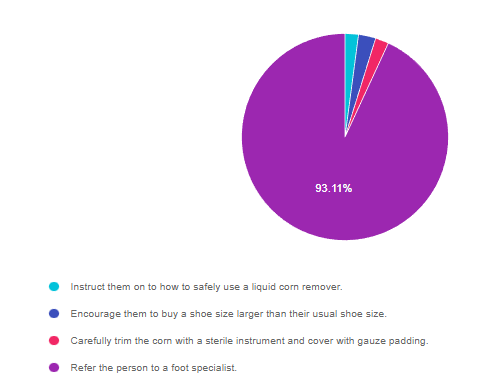
For last week’s practice question, we quizzed test takers on why diabetes foot care is important. 93% of respondents chose the best answer. We want to share this important information, so you can pass it on to people living with diabetes and your colleagues, plus prepare for exam success!
Before we start though, if you don’t want any spoilers and haven’t tried the question yet, you can answer it below: Answer Question
Question: A person with diabetes has small corn on their pinky toe and it bothers them when walking.
What is the best first action?
Answer Choices:
- Instruct them on to how to safely use a liquid corn remover.
- Encourage them to buy a shoe size larger than their usual shoe size.
- Carefully trim the corn with a sterile instrument and cover with gauze padding.
- Refer the person to a foot specialist.

As shown above, the most common choice was option 4, the second most common answer was option 2, then a tie for options 1 and 3.
Getting to the Best Answer
Answer 1 is incorrect. 2.10% chose this answer, “Instruct them on to how to safely use a liquid corn remover.” The problem with corn and callus liquid or patch treatments, is that they contain salicylic acid, which can remove the callus/corn, but also damage the healthy tissue underneath. This disruption in skin integrity can lead to ulcerations and increase the risk of skin infections, especially if the person with diabetes is experiencing blood glucose elevations. We have created foot care education sheets in English and Spanish that you are invited to print and share. Let’s prevent the agony of “DeFeet”. Foot Care Teaching Sheet – Steps to Healthy Feet. Foot Care Teaching Sheet in Spanish– Pasos Para Tener Pies Sanos.
Answer 2 is incorrect. 2.69% of you chose this answer, “Encourage them to buy a shoe size larger than their usual shoe size.” While it is important to make sure there is plenty of room to wiggle toes and avoid rubbing from tight fitting shoes, it is also important to avoid ill fitting shoes. Wearing too large of shoes can lead to slippage and increased friction resulting in blisters and ulcers. These teaching sheets demonstrate an easy strategy to make sure that people are wearing the best size shoes for their foot shape. Foot Care Teaching Sheet – Steps to Healthy Feet. Foot Care Teaching Sheet in Spanish– Pasos Para Tener Pies Sanos.
Answer 3 is incorrect. 2.10% of respondents chose this answer, “Carefully trim the corn with a sterile instrument and cover with gauze padding.” People diabetes are strongly discouraged from performing any “bathroom surgery” to self-treat foot problems. Approved foot care tools for foot care include, nail clippers, nail file, soap and water, washcloth, gentle scrub brush, lotions, socks and shoes. We have created foot care education sheets in English and Spanish that you are invited to print and share. Let’s prevent the agony of “DeFeet”. Foot Care Teaching Sheet – Steps to Healthy Feet. Foot Care Teaching Sheet in Spanish– Pasos Para Tener Pies Sanos.
Finally, Answer 4 is incorrect. 93.11% chose this answer, “Refer the person to a foot specialist.” GREAT JOB. Most people chose this answer for good reason, the action of referring a person with foot problems to a Podiatrist significantly reduces the risk of ulceration, infection and amputation. By identifying and referring people with high risk feet to specialists, we can reverse the trend of increasing amputations and improve quality of life. We are happy to share these free lower extremity education handouts with you. Please feel free to print and share! Foot Care Teaching Sheet – Steps to Healthy Feet. Foot Care Teaching Sheet in Spanish– Pasos Para Tener Pies Sanos.
Want to learn more about this question?
Enroll in our Foot Screening Bundle, now on Sale!
This bundle includes our 3 Steps to Save Feet; Assess, Screen, and Report Webinar + 20-pack of Monofilament + ADA Foot Screening Chart
People with diabetes are at increased risk of foot complications. Basic foot care education and intervention can reduce the risk of amputation by over 50 percent.
This bundle comes with our:
We have included instructions on assessing and inspecting feet, risk assessment, and action steps. We enhanced the teaching tools and forms from the Lower Extremity Prevention Program (LEAP) and are excited to share them with our community of diabetes advocates.
FREE Resources for Health Care Professionals and People with Diabetes
3 Steps to Save Feet – Assess, Screen, Report Handout. This handout walks health care professionals through the steps involved in a 10-minute foot assessment and monofilament screening. Also includes a Screening Form to document and report findings.
Foot Care Teaching Sheet – Steps to Healthy Feet. This handout covers the important elements of foot care for people living with diabetes with simple and straightforward language.
Foot Care Teaching Sheet in Spanish– Pasos Para Tener Pies Sanos. This handout covers the important elements of foot care for people living with diabetes with simple and straightforward language.
FREE Handouts and Resources
Read More: FREE Handouts and Resources 3 Steps to Save Feet – Assess, Screen, Report Handout. This handout walks health care professionals through the steps involved in a 10-minute foot assessment and monofilament screening. Also includes a Screening Form to document and report findings. Foot Care Teaching Sheet – Steps to Healthy Feet. This handout covers the important elements of foot care for people living with diabetes with simple and straightforward language. Foot Care Teaching Sheet in Spanish– Pasos Para Tener Pies Sanos. This handout covers the important elements of foot care for people living with diabetes with simple and straightforward language. Sign up for Diabetes Blog Bytes – we post one daily Blog Byte from Monday to Friday. And of course, Tuesday is our Question of the Week. It’s Informative and FREE! Sign up below! The use of DES products does not guarantee the successful passage of the CDCES exam. CBDCE does not endorse any preparatory or review materials for the CDCES exam, except for those published by CBDCE.









